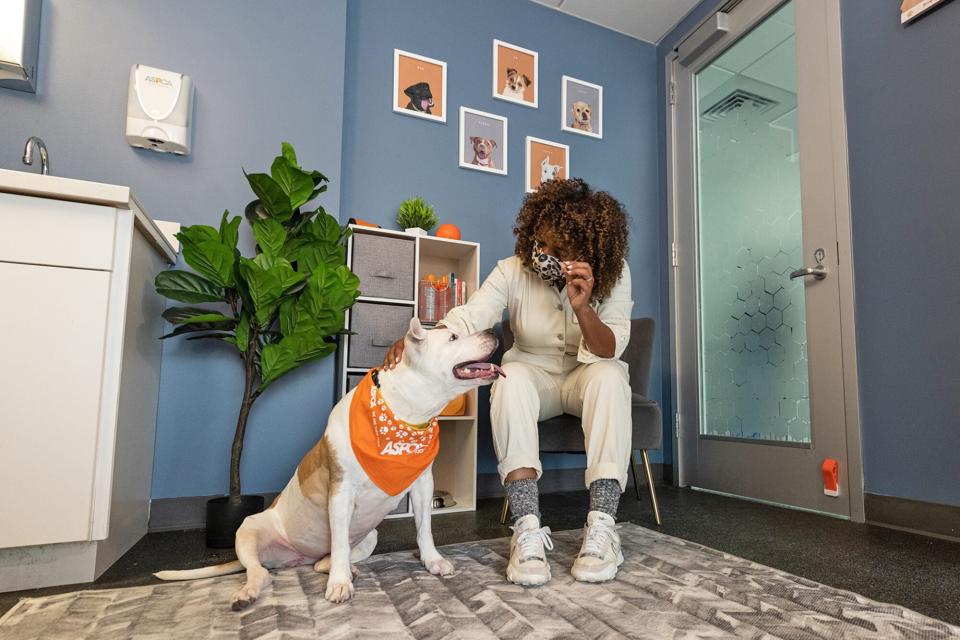How a Real-life Room Helped This Stressed-out Rescue Dog Find a New Home

Courtesy of ASPCA
Animal shelters, even the best ones, simply aren't the best environments for dogs. Being so close to other pups in a big, noisey kennel area can stress them out.
That's what was happening to Bugs, a 5-year-old mixed-breed dog who was staying at the ASPCA Adoption Center in New York City. His unfamiliar surroundings turned him into a different, much more anxious dog. Enter the real-life room.
The room's purpose is in the name. Designed by Dayna Isom Johnson—a judge on NBC crafting show Making It—the quiet space imitates a home's living or family room. No barking dogs; no busy people. Just relaxed dogs, including Bugs.
Spending time in the room—and in an ever-important foster home—eventually led Bugs to his adopter, graphic designer Peter Kaplan.
"While I was aware that he had experienced some challenges, the Bugs that I met was delightful, and he has adjusted well in my home," he wrote in an email to Daily Paws.
RELATED: What You Need To Know About the 4,000 Beagles Being Rescued From a Virginia Breeding Facility
Bugs's Transformation
This pup actually lived in an NYC home before he arrived at the ASPCA, but his owners decided to surrender him because they couldn't manage his energy. He arrived back at the ASPCA in January.
After spending almost all his life in a home, he was unable to adjust to being in a shelter, which is filled with other pets and busy with activity. Even in well-funded shelters with caring staff, the peaceful comforts of home are hard to find.
He's hardly the only one, but Bugs didn't react well.
"In his kennel, we noticed that he often paced while barking, panting, and sometimes drooling, which are signs of anxiety. He was too stressed to eat or rest," said Rachel Maso, director of animal behavior at the ASPCA Adoption Center.

Courtesy of ASPCA
He needed a new place to spend time, so he headed to the blue-painted, secluded real-life room, complete with a box of tennis balls and a comfy-looking crate. The real Bugs finally showed up.
Maso says he became a "completely different dog" when he was in the room. He was cautious at first but then he started to rest for just a few seconds. Then those rests turned into naps in the crate. The room even allowed the ASPCA to learn Bugs's secret talents.
"We learned that he loved doing tricks for treats, which is something he had not done with us before," Maso says. "Without the real-life room, we would have never learned he knew sit, down, and to give his paw."
Bugs soon joined a foster family, where he spent even more time in a home environment where he could be himself. It's also how Kaplan found him. He was working with a dog trainer to find an adoptable dog. That trainer was the one fostering Bugs.
"I liked Bugs right away," Kaplan says. "He was sweet, cuddly, goofy, and passionate, especially about treats. Also, he sat by my feet on our first meeting, which of course won me over very quickly."
He brought his new dog home in March, and Bugs now enjoys "romping around" outdoors along with naps and treats. Kaplan calls him "a really good boy and happy addition to my life."
RELATED: The U.S. Saw More Dogs and Cats Killed in Shelters Last Year, the First Increase in 5 Years
Could These Rooms Help More Dogs Find Homes?
Maso thinks so. Shelters in Chicago, Oregon, and South Carolina already employ them as well, allowing them to give handfuls of dogs breaks from the usual shelter stress. The rooms help the dogs approach potential adopters, and the more dogs who are adopted, the more dogs the shelter can then save.
"It's a wonderful way to improve the quality of life of dogs in shelters and to get to know them better," Maso says.
With Bugs, his time in the room partnered splendidly with his stay at a foster home. Completely out of the shelter, he was able to simply live as a dog without stress.
"Nothing compares to life in a loving home—so we encourage the public to become foster caregivers and volunteers for their local shelters," Maso says. "Even a couple of hours or an overnight in your home could make a huge difference for a dog."

